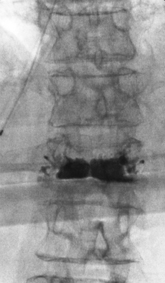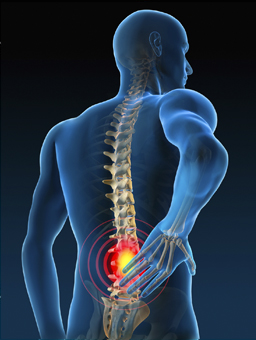Vertebral Compression Fracture (VCFs)
Vertebral Compression Fracture (VCFs) is a collapse of a spinal vertebra. It may be due to trauma or due to a weakened spinal vertebra in a patient with osteoporosis or osteogenesis imperfecta. In healthy patients it is most often seen in individuals suffering extreme vertical shocks, such as ejection seats. Seen in lateral views in plain x-ray films, compression fractures of the spine characteristically appear as wedge deformities, with greater loss of height anteriorly than posteriorly and intact pedicles in the anteroposterior view.
The bones in your spinal column are different than the bones elsewhere in your skeleton. For example, the long bones in your legs are more rigid and dense than the square bones in your spine.
Strong, dense bone enables your legs to withstand rigorous movement. The vertebral bodies, however, are less dense and more “spongy,” to accommodate movements like bending and twisting. Because your vertebral bodies aren’t as strong as the bones in your legs, they can become more vulnerable to fracture.

-

Causes of VCFs
A Vertebral Compression Fracture (VCFs) commonly known as a spinal fracture occurs when one of the bones of the spinal column fractures or collapses. When more than one spinal fracture occurs, loss of height or spinal deformities such as a dowager’s hump may result.
 Osteoporosis
OsteoporosisOsteoporosis is a condition characterized by a decrease in the density of bone, decreasing its strength and resulting in fragile bones. Osteoporosis literally leads to abnormally porous bone that is compressible, like a sponge. This disorder of the skeleton weakens the bone and results in frequent fractures (breaks) in the bones
Normal bone is composed of protein, collagen, and calcium all of which give bone its strength. Bones that are affected by osteoporosis can break (fracture) with relatively minor injury that normally would not cause a bone to fracture. The fracture can be either in the form of cracking (as in a hip fracture) or collapsing (as in a compression fracture of the vertebrae of the spine). The spine, hips, ribs, and wrists are common areas of bone fractures from osteoporosis although osteoporosis-related fractures can occur in almost any skeletal bone.

 Cancer
CancerCancer cells produce factors that enhance their growth. These factors often destroy local bone. When areas of destroyed bone can be seen on X-ray, they are called lesions.
Certain types of cancer, such as multiple myeloma, occur in bone and are known to affect the spine. Other types of cancer occur elsewhere in the body, but spread to the spine. Bone cancer (metastasis) is the spread of cancer from its primary site to the bone. Cancers of the breast, lung and prostate are most likely to spread to the bone, and very often the spine.
Tumors destabilize bone, making it weak and more susceptible to fracture. Cancer cells also stimulate bone destruction, which in turn releases factors that stimulate cancer cell growth.
Cancer cells require nutrients to grow. The rich blood supply in the vertebral body may be the reason that metastatic cancers commonly develop there and over time, spread to the rest of the vertebrae.
 Multiple myeloma
Multiple myeloma Multiple myeloma is a cancer that affects the plasma cells of the bone marrow (the soft bone). This rare and complex disease replaces healthy bone marrow with malignant plasma cells (myeloma cells). As the tumors grow, they invade the hard outer part of the bone. Lesions occur most commonly in the spine.
Myeloma is referred to as "multiple" because more than one area of the bone marrow is usually affected. Multiple myeloma also prevents the bone marrow from forming cells that are important to the immune system, leaving patients vulnerable to infection and disease.
Most myeloma patients experience pain, especially in the lower back. More often than not, back pain and generalized weakness are what bring many undiagnosed myeloma patients to the doctor in the first place.

-

Clinical Consequences
Kyphosis is the term used to describe a forward curvature of the spine. A dowager’s hump or hunchback is often caused by the collapse of spinal vertebrae.
Just one spinal fracture that remains deformed shortens the spine and pushes it forward, adversely affecting spinal alignment. Each additional fracture increases the spinal deformity. This change in spinal alignment can compress your internal organs and affect breathing, eating and digestion. Altering your posture in an attempt to compensate for the kyphotic deformity can affect how you walk and strain your back and joints. All of this can cause medical problems seemingly unrelated to your spine. Some of the health problems related to kyphosis include:

- Reduced lung function
- Reduced ability to take care of yourself or
- perform your nbspusual work or retirement activities
- Reduced days of activity and more days in bed
- Decreased appetite and sleep disorders
- Chronic back pain and fatigue
- Decreased quality of life
- Feelings of isolation and sadness
- Increased risk for future fracture
- Increased risk of death

-

Diagnosis
Many patients mistakenly treated the pain of a spinal fracture to a muscle strain or "minor back pain." Most of the people thought of breaking a bone during normal, non-strenuous activity is difficult to imagine. Further complicating the issue is that VCFs often occur with only mild, or even indiscernible, pain.
Although you might not or cannot even feel your bones getting weaker, you might feel a spinal fracture when it occurs. Severe and sudden pain, out of proportion to the activity at hand, is a sign of a VCF.
These symptoms commonly associated with spinal fractures (VCFs) that are caused by osteoporosis or cancer include:
- Pain is often relieved by lying down
- Pain worsens with sitting or standing
- Sudden onset of back pain, unrelated or out of proportion to activity
If you have a spinal fracture that has not been diagnosed or has been treated without surgical intervention, be advised that the bone usually heals in its fractured position. This can alter the shape of your spine. For example, you or someone else may notice that:
- You are shorter than you used to be
- Your spine is curved forward (commonly called a dowager’s hump)
- Your clothing doesn’t fit properly
The back pains causes by spinal deformity such as described has been shown to negatively affect health and quality of life. Continue to neglect the surgical treatments may worsen your back pain condition and may causes additional complications. Consult your caregivers with all 3 major procedures, Vertebrolplasty, Vertebral Augmentation (Kyphoplasty), or Vesselplasty, and ask for their suggestions to decide which procedure is your best options according to your fracture conditions. They are all minimally invasive procedures that can repair spinal fractures and help you step back into life.



